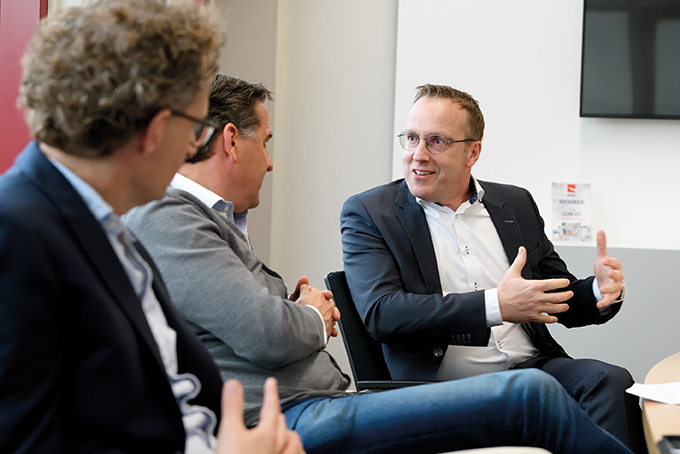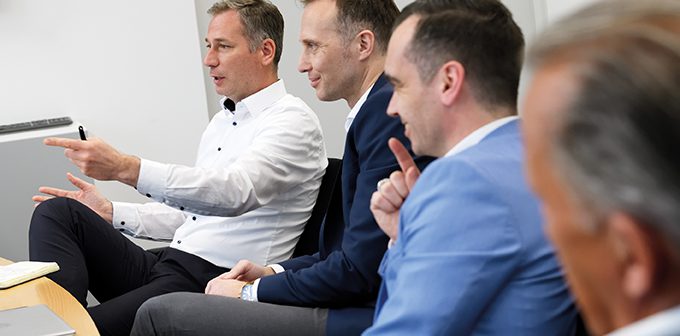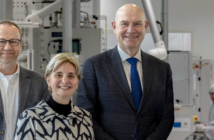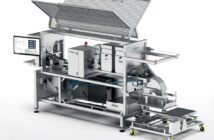A few years ago IAI industrial systems, manufacturer of personalisation machines for passports and ID cards, began professionalising its supply chain. The supply innovation engineers from Topinc are providing support with this. The aim of intensifying the operational cooperation with system suppliers was to help accommodate the anticipated growth. Recent orders for innovative passport machines is putting even more pressure on the chain: closer cooperation in engineering and standardisation are now high on the agenda. A report of a discussion, initiated by Link Magazine and Topinc, in which IAI dares to make itself vulnerable.

At the table at IAI in Veldhoven, from left to right: Leon Hol, Manager Business Line Production Automation, AAE; Frank Mulders, CEO, AAE; Robert Manders, Managing Director, MTA; Eric Peeraer, Director of Operations, IAI; Bart Crols, Managing Director, IAI; John Willems, Sales Director, MTA; Koen In ‘t Ven, Director Sales & Operations, Mevi; Jacco Colen, Managing Director, Mevi. Photos: Bart van Overbeeke
Shifting identities
IAI’s machines are veritable technological gems, with unique features designed to guarantee security or prevent forgery during the process of personalising passports and ID cards. Like the passport photo engraved into the special polycarbonate of the data page, or the photo or numbers perforated into a card using laser technology. No less complex is the environment in which IAI is operating: government assignments, global system integrators and national printing houses for security documents. ‘Following the takeover by HID Global, we really started focusing on personalisation machines and the biggest projects in the world’, says Bart Crols, Managing Director of IAI. ‘We might not be the cheapest, but our machines have features that other parties can’t provide. We can estimate fairly well whether we’ll get an order, but in terms of timing – i.e. when that order will come in – we’re always dependent on a very unpredictable tendering process’, he says, outlining the planning problem for IAI – in engineering, where most machines are largely customer-specific, and in production. ‘In order to be able to grow ourselves, we for the most part had to accommodate that growth within our supply chain. We’d been working with AAE for quite some time, but were looking for more strategic partners.’ These were MTA and Mevi. The three system suppliers build complete sections for the IAI machines, each with their own specific functionality, says Eric Peeraer, Director of Operations at IAI. ‘We put these together to make a complete machine, adding special modules if need be—for inkjet printing, for instance—and which we’ll then fully calibrate and deliver in line with the customer’s requirements.’
Engineering-centric
This cooperation with suppliers is unique in IAI’s world, says Crols. ‘And yet we still need to push it forward. IAI was always an engineering-centric organisation and it’s only in the past four years or so that our focus has been more on sales and operations. We ourselves need to keep innovating, for the features that make our machinery unique, and engineering will need to start cooperating more with our system suppliers and specialist technology firms.’ Leon Hol wholeheartedly concurs. ‘I spent three months working for AAE managing the Production Automation business line when large orders were imminent. We were already working closely with IAI, on a build-to-print basis. We had to do our utmost to push their orders through our organization. Even though we saw opportunities to improve things in the product and hence also in production, and also had the engineering capacity to this end, just like the other two partners. For those new large orders there’s an ongoing discussion within IAI on certain input options. All three of us would like to contribute our opinions on those.’ Which makes sense, acknowledges Peeraer from IAI. ‘Our organisation is gradually starting to realise that. But the hardest part is the culture change.’

Robert Manders from MTA (right): ‘More configure-to-order will ensure more flow in the production process and a greater degree of calm in the chain.’
Hybrid model
Hol is happy that the four parties’ management and operations teams are now in dialogue. ‘That didn’t happen before. We can help each other, in engineering too. IAI’s core business is in laser technology, features and software, and we’re more than capable of supporting the rest – the non-core – based on our engineering experience.’ Not that all of IAI’s engineering should be transferred to the system suppliers, clarifies Frank Mulders, CEO of AAE. ‘I don’t see it in such black and white terms. A hybrid model will enable you to send engineers from the system suppliers to IAI to collaborate there with IAI’s engineering team, allowing IAI to remain in control.’ The other partners agree with this suggestion. Koen In ‘t Ven, Director Sales & Operations at Mevi: ‘The advisable thing to do would be to form the right partnerships in engineering.’ John Willems, Sales Director at MTA: ‘We want to provide our input for the TPD (technical product documentation, ed.). Preferably being involved in conceptual explorations already, to connect the system architecture with the industrialisation. That could prevent things ending up in the machine architecture that we’d rather see were different, but wouldn’t have any influence over further down the line. And enable us to address the challenges IAI faces in terms of an order’s cost price, turnaround time and feasibility at the front end of the engineering process. Which would be the next level in outsourcing for IAI.’
Challenge
Robert Manders, Managing Director of MTA, does understand the trepidation within IAI. ‘This form of cooperation requires a lot of trust. Going for the hybrid model makes it easier to maintain internal support.’ Koen In ‘t Ven from Mevi: ‘We’re eager to contribute our thoughts in engineering. We already spotted things that could be done better when we received our first orders for IAI. IAI, accept the challenge.’ Bart Crols takes up the gauntlet: ‘It used to be the case that we’d forget to listen to other departments than our own engineering team and we didn’t factor in cost price and deliverability into our designs. We have now learned that it’s not engineering but innovation that’s the principal part of our work. So let’s try and get more of the engineering into the chain.’ Perhaps it could start simply with the question put by Jacco Colen, Managing Director at Mevi: ‘Are IAI’s engineers already visiting suppliers?’ Rarely up till now, Eric Peeraer has to admit. Manders picks up on this: ‘If your engineers come and take a look at what’s going on in us three’s businesses, then it’ll make it easier for our technical people to engage in dialogue.’ AAE’s Mulders is keen to give this initiative tangible form: ‘We do want to discuss the module we’re supplying to IAI with the whole group, to enable all the parties’ engineers to look at it collectively, so as to learn from each other where there’s room for improvement.’

uitsnede ? dan kan “(centre)” vervallen >
Frank Mulders from AAE (centre): ‘I’d like to have greater insight into the wonderful world of IAI’s customers, so that we can take dosed risk.’
Forecast
Besides the cooperation within engineering, the current sticking point is the scaling up of production, particularly the planning thereof. Peeraer: ‘At IAI, we’re keen to give the supply chain clarity on the future through our non-binding forecast. How are you finding that?’ Koen In ‘t Ven: ‘The first order we got from IAI immediately put pressure on our delivery. We haven’t received a good forecast yet. Our suppliers would really appreciate one. We’d like to use such a forecast for scenario planning: what do we need to do when a particular order comes in? For example, do we need to reserve capacity in our flexi-shell?’ Willems from MTA understands the dynamism in IAI’s projects. ‘It would help to know what potential orders are in the pipeline.’ His director, Robert Manders, argues the case for further standardisation of IAI’s machinery by building them as far as possible out of standard components and modules. Then individual orders would require less engineering—order processing would become a matter of configuration—and components and modules could be ordered and produced in advance, separate from those orders. ‘As long as everything is still being done on a project-by-project basis, we’ll get repeat orders, but 30 to 60 percent redesign will be necessary each time. More configure-to-order will ensure more flow in the production process and a greater degree of calm in the chain.’
Long-lead items
The most significant pain at present is in the purchasing of items with long lead times, a growing problem arising as a result of the worldwide industrial bubble. For certain types of drives and guides, for example, the delivery times are steadily rising. Peeraer: ‘Our Supply Chain Manager, Gil Heijmans (seconded to IAI by Topinc, ed.) is engaged in inventorying the bottlenecks and looking for a formula that will be workable for everyone.’ Leon Hol is keen to discuss the bottlenecks periodically: ‘It’ll save a great deal of anxiety if we can order in long-lead items in advance before an order is actually placed.’ The financing needn’t be a problem, say Koen In ‘t Ven and Jacco Colen from Mevi. ‘Any extra costs for stock will be compensated by fewer last-resort measures being required if certain items are not being supplied on time. What’s more, we do have confidence that the machines will be purchased, including those long-lead items. It’s all about planning people, materials and capacity.’ There are some smart models that are conceivable to this end, says Mulders. ‘What I’d also like to have is greater insight into the wonderful world of IAI’s customers, so that we can take dosed risk. The period over which those long-lead items get called up from stock can be pretty long, as long as there’s commitment.’
Compliment
The partners have no gripes about mutual commitment, Eric Peeraer illustrates. ‘We recently completed the site acceptance test for a large order in the UK. The customer showered us with praise, on the schedule we managed to fulfil too. We appreciate the open way in which we’re able to collaborate with you. Our growth wouldn’t have happened without your support. Compliments to our partners and all suppliers.’ Frank Mulders returns the compliment: ‘The way you told us about your projects and included our people in that story is ensuring that they’re working enthusiastically on projects for IAI and are prepared to go the extra mile.’ MTA’s John Willems cites that UK order as a fine example of chain management: ‘The challenge for us all is to now repeat this performance for the next big order and other projects.’
Supply chain partners
Veldhoven-based IAI (55 staff) is part of HID Global, a worldwide leader in trusted identity solutions. IAI is a specialist in high-tech laser and inkjet applications for security and personalisation of passports and ID cards. The company develops and builds machines such as the BookMaster One and Bookmaster Pro and the CardMaster One.
AAE in Helmond (330 staff) serves the market for low-volume, high-mix, high-tech machine manufacturing with its Advanced Systems and Production Automation business lines. AAE covers project management, (system) engineering and a wide array of precision industry, mechatronic and clean room competencies.
Helmond-based MTA (about 100 staff) is dedicated to the development and serial production of complex mechatronic systems. MTA positions itself as a full-service system supplier specialising in industrialisation and smart customisation.
Mevi in Helmond (115 staff) provides machining, mechanical engineering and machine and equipment building, and is capable of supporting customers from concept development and engineering to implementation and commissioning.
Eindhoven-based Topinc (6 supply innovation engineers) helps companies in manufacturing, high tech, construction and offshore to organise and improve their supply chain.
Tools for closer engineering cooperation
IAI is speaking with supply chain partners to foster closer cooperation in engineering and further product standardisation. It already has the tools for collaborative engineering and management of modular product families in-house, states Hugo Botter, Managing Director of PLM Xpert. He is referring to Product Life Cycle Management (PLM), for the purposes of which IAI is using the PRO.FILE system. In this regard, PLM Xpert, the PRO.FILE Competence Center for the Benelux region, served as implementation partner. ‘This is the digitisation platform for managing all product data in a single source to keep the technical product documentation (TPD) properly under control.’ This product data backbone makes it possible to manage the TPD and share it with the supply chain correctly. What’s more, PRO.FILE has been integrated with the ERP system ISAH at IAI, meaning that IAI and its chain partners are closely connected during work preparation, production and procurement. Long-lead items and standard modules can thus be released from engineering promptly for the benefit of the supply chain.
Now that there’s a wish (a need) to work more closely together, it’s a question of working out how IAI will organise that, says Botter. ‘First organise, then automate. Thus enabling you to arrange the process in series, for example.’ This would see IAI giving suppliers access to the TPD, enabling them to come up with suggestions for improvement. ‘However, they could also set straight to work on concurrent engineering, with them working on the same TPD in a single team. To this end, PRO.FILE offers the check-in/check-out and locking options, as well as the workflow and processes for controlling and managing the data and the milestones in projects so as to keep change processes under control. Authorisations for access to certain data within a life cycle stage, are easily set in PRO.FILE.’ Botter points out that the package’s strength is that it is easy to adapt it to advancing insight and changing procedures at IAI or in the supply chain. ‘Above all, it’s a question of configuration, and the user can do that himself, with PLM Xpert able to support with knowledge and advice. Such adaptations take days rather than months, with limited software adjustments being necessary. In that respect, PRO.FILE is extremely open and flexible for the user.’






